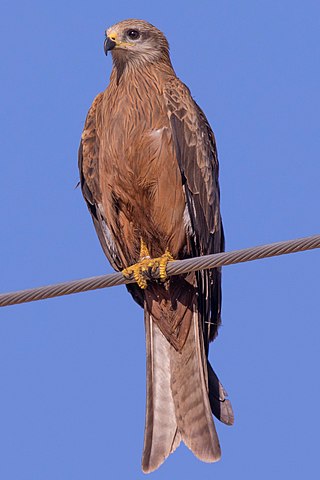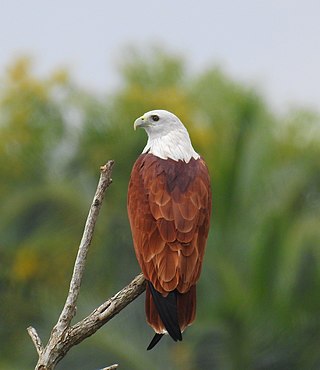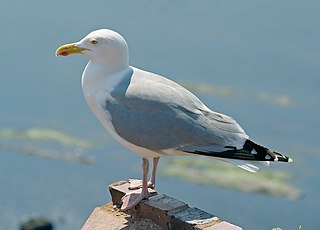Origin of the term
The term "shite-hawk" is believed to have originated as military slang by the British Army in India and Egypt, as a derogatory term for the black kite (Milvus migrans), which was despised by soldiers for its habit of stealing food from their plates: [2] [3]
At the transit camp the British soldier normally made his acquaintance with the kite-hawk [i.e. black kite], known familiarly as the 'shite-hawk'. 'There used to be thousands of them,' remembers Charles Wright. 'When one drew one's food from the cook-house and went to take it across to the dining room to eat at the tables underneath the sheds, these kite-hawks would swoop down and take the lot off your plate if you weren't careful. So you had to walk waving your arms above the plate until you got it under cover.'
Eric Partridge, an etymologist, claimed that the term was used to refer to the vulture by the soldiers in the British Army in India during the period 1870–1947, although the earliest recorded use of the term in print in the Oxford English Dictionary is 1944. [2] In recent years, in the United Kingdom, the term "shite-hawk" has also been applied to the herring gull (Larus argentatus), which is known for its mobbing and scavenging behaviour. [2] [5]
Referring to the red kite
Although "shite-hawk" originally referred to the black kite in India and elsewhere, and British naturalists Mark Cocker and Richard Mabey explicitly note that the "red kite never suffered the indignity of its relative's nickname", [3] in recent years, following the successful reintroduction of the red kite into Scotland and England during the 1990s, the term has also started to be used for the red kite in Britain, apparently due to confusion between the two species of kite. Thus, in 1999, Lord Burton announced in the House of Lords that "[p]ossibly one of the most highly protected birds today is the [red] kite, known by the British Army throughout the world as a shite-hawk". [6]
In March 2011, BBC Radio 4 broadcast a radio programme called The Kestrel and Red Kite, in which presenter Rod Liddle repeatedly asserted that the red kite (Milvus milvus) was historically known as the shite-hawk in England. [7] However, he provided no evidence for this assertion, and the only other references to the red kite being called a shite-hawk in medieval times are very recent, for example a historical novel published in 2011 (but set in 1513), [8] and in a poem written by Christopher Hodgson (published 2005):
And in Medieval times, with waste piled publicly,
Its habit of scavenging in sewage
Earned it the sobriquet, "Shite hawk" — Red Kite by Christopher Hodgson [9]

Birds of prey or predatory birds, also known as raptors, are hypercarnivorous bird species that actively hunt and feed on other vertebrates. In addition to speed and strength, these predators have keen eyesight for detecting prey from a distance or during flight, strong feet with sharp talons for grasping or killing prey, and powerful, curved beaks for tearing off flesh. Although predatory birds primarily hunt live prey, many species also scavenge and eat carrion.

Hawks are birds of prey of the family Accipitridae. They are very widely distributed and are found on all continents except Antarctica.

Kite is the common name for certain birds of prey in the family Accipitridae, particularly in subfamilies Milvinae, Elaninae, and Perninae. The term is derived from Old English cȳta, from the Proto-Indo-European root *gū- , "screech."

The red kite is a medium-large bird of prey in the family Accipitridae, which also includes many other diurnal raptors such as eagles, buzzards, and harriers. The species currently breeds only in Europe, though it formerly also bred in west Asia and northwest Africa. Historically, it was only resident in the milder parts of its range in western Europe and northwestern Africa, whereas all or most red kites in northern mainland Europe wintered to the south and west, some also reaching western Asia, but an increasing number of northern birds now remain in that region year-round. Vagrants have reached north to Finland and south to Israel, Libya and Gambia.

The black kite is a medium-sized bird of prey in the family Accipitridae, which also includes many other diurnal raptors. It is thought to be the world's most abundant species of Accipitridae, although some populations have experienced dramatic declines or fluctuations. Current global population estimates run up to 6.7 million individuals.

The black-winged kite, also known as the black-shouldered kite, is a small diurnal bird of prey in the family Accipitridae best known for its habit of hovering over open grasslands in the manner of the much smaller kestrels. This Palearctic and Afrotropical species was sometimes combined with the Australian black-shouldered kite and the white-tailed kite of North and South America which together form a superspecies. This kite is distinctive, with long wings; white, grey and black plumage; and owl-like forward-facing eyes with red irises. The owl-like behaviour is even more pronounced in the letter-winged kite, a nocturnal relative in Australia. Although mainly seen on plains, they are sometimes seen on grassy slopes of hills in the higher elevation regions of Asia. They are not migratory, but show nomadism in response to weather and food availability. They are well adapted to utilize periodic upsurges in rodent populations and can raise multiple broods in a single year unlike most birds of prey. Populations in southern Europe have grown in response to human activities, particularly agriculture and livestock rearing. Now present in SouthWest France

The brahminy kite, also known as the red-backed sea-eagle in Australia, is a medium-sized bird of prey in the family Accipitridae, which also includes many other diurnal raptors, such as eagles, buzzards, and harriers. They are found in the Indian subcontinent, Southeast Asia, and Australia. They are found mainly on the coast and in inland wetlands, where they feed on dead fish and other prey. Adults have a reddish-brown body plumage contrasting with their white head and breast which make them easy to distinguish from other birds of prey.

Gulls, or colloquially seagulls, are seabirds of the family Laridae in the suborder Lari. They are most closely related to the terns and skimmers and only distantly related to auks, and even more distantly to waders. Until the 21st century, most gulls were placed in the genus Larus, but that arrangement is now considered polyphyletic, leading to the resurrection of several genera. An older name for gulls is mews, which is cognate with German Möwe, Danish måge, Swedish mås, Dutch meeuw, Norwegian måke/måse, and French mouette, and can still be found in certain regional dialects.

The European herring gull is a large gull, up to 66 cm (26 in) long. Common in coastal regions of Western Europe, it was historically more abundant. It breeds across Northern Europe, Western Europe, Central Europe, Eastern Europe, Scandinavia, and the Baltic states. Some European herring gulls, especially those resident in colder areas, migrate further south in winter, but many are permanent residents, such as in Ireland, Britain, Iceland, or on the North Sea shores. They have a varied diet, including fish, crustaceans, as well as some plants, and are also scavengers, consuming carrion and food left by or stolen from humans.

The yellow-legged gull is a large gull found in Europe, the Middle East and North Africa, which has only recently achieved wide recognition as a distinct species. It was formerly treated as a subspecies of either the Caspian gull L. cachinnans, or more broadly as a subspecies of the herring gull L. argentatus. The genus name is from Latin Larus which appears to have referred to a gull or other large seabird, and the species name honours the German zoologist Karl Michahelles.

An elanine kite is any of several small, lightly-built raptors with long, pointed wings.

Milvus is a genus of medium-sized birds of prey. The genus was erected by the French naturalist Bernard Germain de Lacépède in 1799 with the red kite as the type species. The name is the Latin word for the red kite.

Haliastur is a genus of medium-sized diurnal birds of prey. It consists of two species of kites which form part of the subfamily Milvinae; some authorities place these species in the genus Milvus, despite clear differences in behaviour, voice and plumage.

The black-collared hawk is a species of bird of prey in the family Accipitridae. It is monotypic within the genus Busarellus. It has a widespread range of presence, from western Mexico to Uruguay. Its natural habitats are subtropical or tropical moist lowland forests, subtropical or tropical swamps, and swamps.

Hawkwatching is a mainly citizen science activity where experienced volunteers count migratory raptors in an effort to survey migratory numbers. Groups of hawkwatchers often congregate along well-known migratory routes such as mountain ridges, coastlines and land bridges, where raptors ride on updrafts created by the topography. Hawkwatches are often formally or informally organized by non-profit organizations such as an Audubon chapter, state park, wildlife refuge or other important birding area. Some hawkwatches remain independent of any organizing structure.















